With City of Chimeras, the Russian art collective AES+F extends its conceptual exploration of Inverso Mundus (World upside down), delving deeper into the symbolic and cultural implications of the chimera. Historically, the chimera has been associated with hybridity and monstrosity, a creature composed of disparate animal forms that, in classical mythology, signified both physical threat and metaphysical transgression. Over time, this image has evolved from a representation of chaos and danger to a broader metaphor for illusion, unattainable aspirations, and the instability of identity. AES+F's latest series reinterprets this mythological being not as an object of fear, but as a familiar and even endearing presence—an approach that challenges traditional conceptions of beauty, normality, and the aesthetic integration of the monstrous into the everyday.
The absorption of the monstrous into quotidian life has been a recurrent theme in literature, philosophy, and the visual arts. AES+F’s work resonates with Franz Kafka’s The Metamorphosis (1915), in which Gregor Samsa’s inexplicable transformation into an insect is met not with existential dread but with pragmatic adaptation. The horror of his new form is gradually normalized within the domestic sphere, underscoring how the grotesque, when confronted repeatedly, loses its power to shock and instead becomes embedded within the structures of daily life. This process of normalization is central to City of Chimeras, where AES+F presents fantastical hybrid creatures not as anomalies but as extensions of contemporary subjectivity. By domesticating the chimera, the collective reflects on the ways in which modern society assimilates its own illusions, desires, and distortions, integrating them into the visual and cultural landscape.
AES+F’s artistic practice has long been defined by a fusion of classical and contemporary visual languages, and City of Chimeras continues this tradition. The paintings in this series, unique oil-on-canvas works, originate from the broader Inverso Mundus project, a multimedia endeavor that merges live human figures with digitally generated imagery. This hybridization of artistic methodologies mirrors the conceptual themes of the work: just as the chimera embodies a collision of disparate forms, AES+F’s technique collapses traditional oil painting into a digital aesthetic, creating a visual language that is simultaneously archaic and futuristic. The result is a liminal aesthetic space, in which past and present, myth and reality, materiality and immateriality converge.
The exhibition also engages with a broader philosophical discourse on the nature of transformation, illusion, and paradox. AES+F’s work can be situated within a lineage of artists who have interrogated the aestheticization of the grotesque, from Hieronymus Bosch’s fantastical visions of hybrid creatures in The Garden of Earthly Delights (c. 1490–1510) to Francisco Goya’s Los Caprichos (1797–98), which satirized the social and political chimeras of his time. And we can’t miss to observe that for decades the collective’s hyper-stylized compositions anticipated the digital surrealism of contemporary visual culture, in which AI-generated imagery blurs the boundaries between reality and simulation. The chimera, in this context, becomes not just a mythological reference but a reflection of the unstable nature of contemporary identity, where digital avatars, virtual personas, and algorithmic constructs redefine the parameters of selfhood.
At its core, City of Chimeras is an exploration of the contradictions inherent in the contemporary moment. By transforming creatures of danger into icons of adoration, AES+F subverts the traditional dynamics of fear and attraction, revealing a world in which instability and contradiction are not only tolerated but embraced. Just as Kafka’s Samsa exists in a perpetual state of in-betweenness, neither fully human nor fully insect, neither entirely rejected nor wholly accepted, the chimeras of AES+F occupy a liminal space in which categories dissolve and new possibilities emerge. This exhibition challenges viewers to reconsider their own perceptions of beauty, horror, and transformation, positioning the chimera as an emblem of the fluid, hybrid, and ever-evolving nature of contemporary existence.
EXHIBITING WORKS
 AES+F Inverso Mundus, Four Women with Catpig Oil on canvas 240 x 181 cm 2024 |  AES+F Inverso Mundus, Celestial Cities of Chimeras Oil on canvas 200 x 450 cm 2024 |  AES+F Inverso Mundus, Young Men with Mousefish Oil on canvas 180 x 223 cm 2024 |
|---|---|---|
 AES+F Inverso Mundus, Sealdog Oil on canvas 75 x 60 cm 2024 |  AES+F Inverso Mundus, Women with Chimeras Oil on canvas 205 x 150 cm 2024 |  AES+F Inverso Mundus, Pugtopus Oil on canvas 75 x 60 cm 2024 |
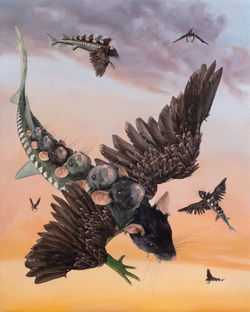 AES+F Inverso Mundus, Mousefish Oil on canvas 75 x 60 cm 2024 | 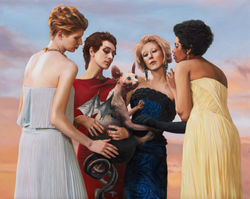 Inverso Mundus, Four Women with Catpig Oil on canvas 100 x 125 cm 2024 |  AES+F Inverso Mundus, Mother and Daughter with Catpig Oil on canvas 205 x 150 cm 2024 |
 AES+F Inverso Mundus, Brainfish Oil on canvas 75 x 75 cm 2024 | 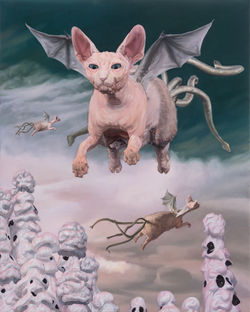 AES+F Inverso Mundus, Catpig Oil and fabric on canvas 75 x 60 cm 2024 | 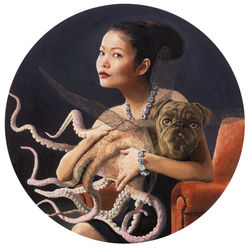 AES+F Inverso Mundus, Lady with Pugtopus Oil on canvas D-120 cm 2024 |
 AES+F Inverso Mundus, Gentleman with Sealdog Oil and fabric on canvas D-120 cm 2024 | 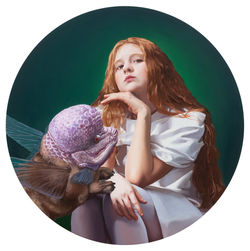 AES+F Inverso Mundus, Girl with Brainfish Oil on canvas D-100 cm 2024 |  AES+F Inverso Mundus, Boy with Mousefish Oil on canvas D-100 cm 2024 |
Artists
.jpg)
AES+F
formed 1987, Moscow, Russia
Lives and works in Berlin/New York
The AES+F art group was initially formed in 1987 by Tatiana Arzamasova, Lev Evzovich, and Evgeny Svyatsky, originally named AES Group. In 1995, Vladimir Fridkes joined, and the group was renamed AES+F. Their works integrate traditional media, photography, video, and digital technology, defining their creations as a form of "social psychological analysis" that reveals and explores the values, flaws, and conflicts of contemporary global culture.
AES+F is known for its visual impact and profound social critique, particularly highlighted by their work "Last Riot," exhibited at the 2007 Venice Biennale, which sparked widespread attention and discussion. This piece uses surreal imagery and dramatic narratives to explore violence, power, and the fragility of human existence.
The group's creative style combines photography, video, and digital technology, often employing rich visual symbols and metaphors in their works. AES+F's art is not merely an expression of aesthetics but also a reflection on contemporary social issues. Their creations frequently address globalization, identity, and cultural conflict, seeking meaning in a chaotic reality.
AES+F's works are widely exhibited internationally and are collected by numerous significant museums and private collections. Their artistic practice continually challenges public perception, prompting deeper consideration of the complexities of the current world.
AES+F's works demonstrate their concern for human existence and offer a critical perspective on contemporary society. Their art is not only a pursuit of beauty but also a profound reflection on social realities, sharing narratives of human vulnerability and hope.



